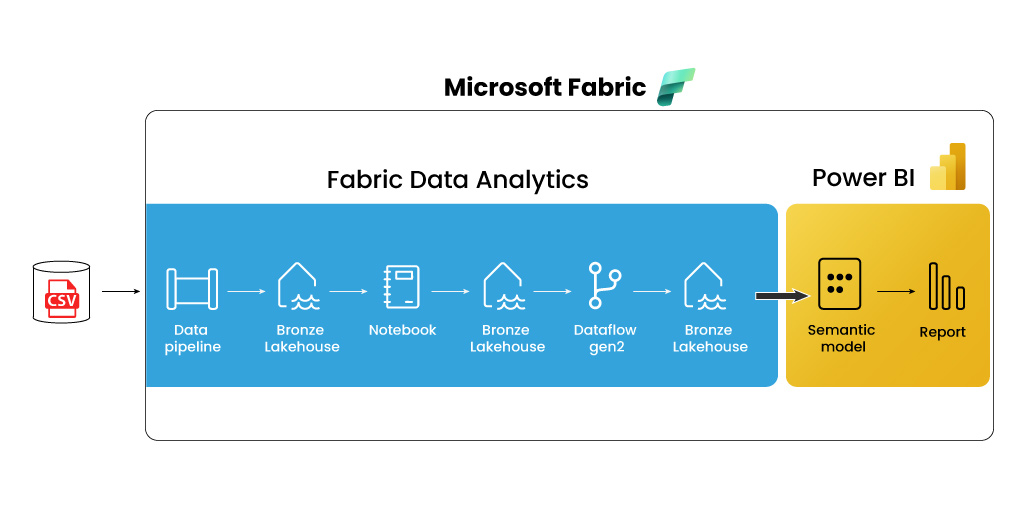Microsoft Fabric is an integrated analytics platform that simplifies data management, processing, and analysis, combining various Azure services to handle data workflows seamlessly.
Regarding high-volume data, Microsoft Fabric integrates essential data services into one ecosystem, providing advantages such as scalability, agility, and robust real-time intelligence without needing multiple applications to handle them.
Overview of the main benefits:
|
This blog will explore leveraging Microsoft Fabric’s key features and components to achieve high-volume data management, real-time intelligence, and optimized data pipelines.
Layers within the Microsoft Fabric Architecture
The architecture of Microsoft Fabric is designed to support seamless data movement and high-volume processing. Let’s explore the key components that enable efficient data workflows in Microsoft Fabric:
- Data Ingestion Layer: This layer manages data import from various sources, supporting batch and real-time ingestion for flexibility.
- Data Storage Layer: This layer uses Azure Data Lake Storage (ADLS) for secure, scalable, structured, and unstructured data storage.
- Processing and Transformation Layer: Employs Fabric Analytics to process and transform data, offering real-time intelligence capabilities.
- Visualization Layer: Power BI provides powerful tools for visualizing data, making insights easily accessible to stakeholders.
Key System Components in Microsoft Fabric
Microsoft Fabric integrates several Azure services, each playing a unique role in managing the data lifecycle—from ingestion to visualization:
- Azure Data Factory (ADF): Automates data ingestion, processing, and movement across services, allowing you to build complex data workflows with ease.
- Azure Data Lake Storage (ADLS): Supports high-volume data storage and security, providing structure for raw, cleansed, and enriched data.
- Fabric Analytics: A versatile analytics engine that merges big data and data warehousing for high-performance processing, making it easy to scale data workflows.
- Power BI: Allows you to visualize data insights with real-time dashboards and promotes a data-driven culture across your organization.
Techniques for High-Volume Data Loading
To manage large datasets efficiently, Microsoft Fabric offers specific techniques to optimize data loading and storage:
|
Case Study: Implementing Microsoft Fabric for Retail Analytics
Consider a retail business analyzing sales and inventory data from thousands of locations. Here’s how Microsoft Fabric can streamline this data workflow:
- Data Ingestion: Azure Data Factory pulls data from point-of-sale systems and inventory databases.
- Storage and Transformation: Azure Data Lake Storage (ADLS) stores the raw data, and Fabric transforms it into meaningful insights.
- Visualization: Power BI presents real-time dashboards for sales forecasting and inventory management.
This integration helps the retailer make informed decisions on stock levels, demand forecasting, and customer satisfaction.
6 Challenges with High-Volume Data in Microsoft Fabric (And How to Solve Them)
- Storage and Cost Overruns
- Problem: High data volumes can drive up storage costs, especially with long-term retention of raw, processed, and archived data.
- Solution: Compress data at ingestion and storage layers, set up data retention policies to archive rarely accessed data in cold storage, and use partitioned storage in ADLS for efficient retrieval.
- Slow Query Performance
-
- Problem: As data grows, queries can slow down, impacting decision-making.
- Solution: To speed up queries, use partitioning and distributed processing in Fabric. Cache frequently accessed data and streamline query logic for optimal performance.
- High Real-Time Processing Costs
- Problem: Real-time data processing requires intensive computing power, which can quickly become
- Solution: Balance by processing only critical data in real-time, with incremental data loading and serverless compute options to cut costs.
- Dashboard Latency
- Problem: Delays in data refreshes lead to outdated insights on dashboards.
- Solution: Leverage Power BI’s streaming dataflows for real-time updates, limit data to critical metrics, and use caching to reduce latency.
- Complex Pipeline Management
- Problem: Multiple actions and dependencies make high-volume data pipelines hard to manage.
- Solution: Orchestrate workflows in ADF, set up alerts for issues, and document data lineage to streamline monitoring and troubleshooting.
- Long Data Ingestion Times
- Problem: Large, varied data sources can slow ingestion times.
- Solution: Use delta loading to capture only new records and leverage distributed ingestion in Fabric for faster batch processing.
Optimizing Data Pipelines in Microsoft Fabric
To accelerate processing and insight generation in Microsoft Fabric, consider these advanced techniques:
- Parallel Processing: Maximize speed by leveraging Azure Data Factory (ADF) and Fabric’s parallel processing capabilities. Tasks are distributed across multiple nodes for rapid execution.
- Parallel Data Ingestion: ADF enables simultaneous data ingestion from multiple sources, enhancing speed and efficiency.
- Distributed Processing in Fabric: Fabric’s distributed query engine breaks down tasks across compute nodes, enabling faster, parallel query execution for large datasets.
- Incremental Data Loads: Instead of reloading entire datasets, incremental loading captures only new or modified data. This reduces both compute costs and load times, improving overall efficiency.
- Caching and Partitioning: Enhance data retrieval speed by caching frequently accessed data and partitioning datasets. This minimizes the volume of data processing for each query, reducing latency.
- Partitioning in ADLS and Fabric: Partition data by commonly queried dimensions—such as date or region—to optimize query performance, allowing targeted retrieval of relevant data.
- Query Caching in Fabric: Cache popular query results to minimize repeated retrieval times, enhancing response speed for frequently accessed insights.
By applying these strategies, Microsoft Fabric users can optimize performance, reduce costs, and accelerate their data-driven insights for faster, more efficient analytics.
Final Thoughts
Microsoft Fabric is a powerful solution for businesses dealing with large-scale data analytics. Its components, best practices, and optimization techniques allow organizations to achieve real-time intelligence and streamline data workflows. By managing the entire data pipeline—from ingestion to visualization—Microsoft Fabric enables companies to meet the demands of today’s data-centric landscape.
PreludeSys helps organizations organizations implement Microsoft Fabric services for high-volume data management and real-time intelligence. Our Microsoft Fabric consulting service ensures you get the most out of this platform with tailored solutions to optimize your data workflows and improve decision-making. Connect with PreludeSys, a leading, to harness the platform’s full potential for your business.
This blog is written by Navyanth Chitteti, Data Engineer, PreludeSys












